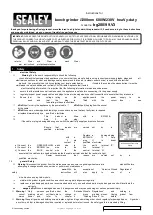
4
5
Don’t expose power tools to rain or wet conditions.
Water entering a
power tool will increase the risk of electric shock.
Do not abuse the cord. Never use the cord to carry the tools or pull
the plug from an outlet. Keep cord away from heat, oil, sharp edges or
moving parts. Replace damaged cords immediately.
Damaged cords
increase the risk of electric shock.
When operating a power tool outside, use an outdoor extension cord
marked “W-A” or “W”.
These cords are rated for outdoor use and reduce
the risk of electric shock. The following table shows the correct size to
use, depending on cord length and nameplate amperage rating of the tool.
When in doubt, use the next heavier gauge. Always use UL and CSA listed
extension cords.
Recommended sizes of extension cords
Tool’s Ampere rating
Volts
Total length of cord in feet
Cord size in A. W. G.(minimum)
25’
50’
100’
150’
0-6
120
V~
18
16
16
14
6-10
18
16
14
12
10-12
16
16
14
12
12-16
14
12
Not Recommended
PERSONAL SAFETY
Stay alert, watch what you are doing and use common sense when
operating a power tool. Do not use tool while tired or under the influence
of drugs, alcohol, or medication.
A moment of inattention while operating
power tools may result in serious personal injury.
Dress properly. Do not wear loose clothing or jewelry. Contain long hair.
Keep your hair, clothing, and gloves away from moving parts.
Loose
clothes, jewelry, or long hair can be caught in moving parts.
Avoid accidental starting. Be sure switch is off before plugging in.
Carrying tools with your finger on the switch or plugging in tools that have
the switch on invites accidents.
Remove adjusting keys or wrenches before turning the tool on.
A wrench
or a key that is left attached to a rotating part of the tool may result in
personal injury.
Do not overreach. Keep proper footing and balance at all times.
Proper
footing and balance enables better control of the tool in unexpected
situations.
Use safety equipment. Always wear eye protection.
Dust mask, non-skid
safety shoes, hard hat, or hearing protection must be used for appropriate
conditions.
Before connecting the tool
to a power source (receptacle, outlet, etc.), be
sure voltage supplied is the same as that specified on the nameplate of
the tool
. A power source with voltage greater than that specified for the
tool can result in serious injury to the user – as well as damage to the tool.
Tool Use and Care
Use clamps or other practical way to secure and support the workpiece
to a stable platform.
Holding the work by hand or against your body is
unstable and may lead to loss of control.
Do not force tool. Use the correct tool for your application.
The correct
tool will do the job better and safer at the rate for which is designed.
Do not use tool if switch does not turn it on or off.
Any tool that cannot be
controlled with the switch is dangerous and must be repaired.
Disconnect the plug from the power source before making any
adjustments, changing accessories, or storing the tool.
Such preventive
safety measures reduce the risk of starting the tool accidentally.
Store idle tools out of reach of children and other untrained persons.
Tools are dangerous in the hands of untrained users.
Maintain tools with care. Keep cutting tools sharp and clean.
Properly
maintained tools, with sharp cutting edges are less likely to bind and are
easier to control.
Check for misalignment or binding of moving parts, breakage of parts,
and any other condition that may affect the tools operation. If damaged,
have the tool serviced before using.
Many accidents are caused by poorly
maintained tools.
Use only accessories that are recommended by the manufacturer for
your model.
Accessories that may be suitable for one tool, may become
hazardous when used on another tool.
Do not alter or misuse tool.
These tools are precision built. Any alteration
or modification not specified is misuse and may result in a dangerous
condition.
Summary of Contents for 241-0781
Page 8: ...14...


























